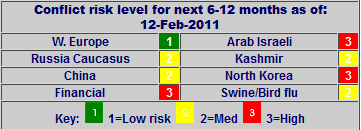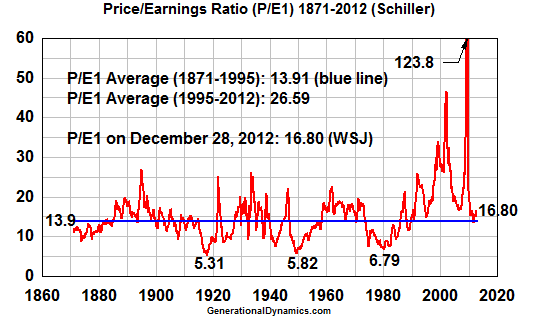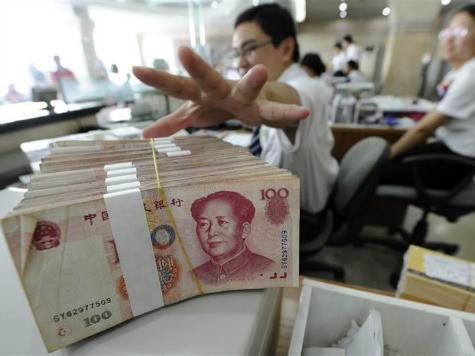
This morning’s key headlines from GenerationalDynamics.com
- Updating Global Conflict Risk Assessment for China threat
- The Most Dangerous Regions of the World
- Forecast for 2013: Financial crisis and China Threat
Updating Global Conflict Risk Assessment for China threat
Starting in 2004, I began posting a “Global Conflict Risk” graphic onthe Home Page of my website. It’s purpose was to encapsulate the current state of the world,and the likelihood of world conflict. The intention was that thegraphic would be updated only rarely, as world events require. Thelast update was in February, 2011, as follows:

Conflict Risk Graphic – February 12, 2011
My thinking in 2004 was that there were six regions of the world thathad the potential for triggering a world war. Thus, there wereimportant regional wars going on in Sri Lanka, Darfur, Congo, andother places, but these wars were unlikely to spiral into major wars.
On the other hand, I believed that a war in any of the six regionsshown in the graphic was likely to spiral into a larger regionalconflict, and then possibly to world war. In addition, I felt that amajor financial crisis or world flu outbreak would trigger a broadwar. Thus, the graphic was indicating my personal assessment of theprobability (green=low, yellow=medium, high=red) of a crisis in eachof these eight categories during the next 6-12 months, since such acrisis was thought likely to trigger a wider war.
My thinking in 2005 has turned out to be wrong. There have beenmultiple wars in the six regions, and they have not spiraled intowider wars. (However, we have not yet had a major financial crisisnor a major flu outbreak.)
One of the reasons that my reasoning turned out to be wrong was that Iassumed that one of these regional wars would cause other countries tobe pulled into the war, causing an uncontrolled spiral. As it turnsout, the opposite happened: Other countries rushed in to force aresolution to the war as quickly as possible, so that it wouldn’tspiral out of control. In most cases, this “resolution” did nothingto solve the underlying problems, but only “kicked the can down theroad” in the familiar way that does the minimum possible to fix thecurrent crisis, leaving the crisis to recur a few weeks or monthslater.
I’m now updating the Global Conflict Risk graphic to reflect this newthinking. The new graphic is as follows:

Conflict Risk Graphic – January 1, 2013
I’m keeping the categories the same, but now when I assign aprobability of conflict in a region, I’m taking into account myassessment of whether a war in that region is likely to pull in othercountries as combatants or as pacifiers.
The Most Dangerous Regions of the World
Let’s go through each of the eight categories, and the probability ofa regional war that will spiral into a world war:
- Europe – Green, low probability. Europe is showing signs of increased xenophobia towards Muslims and Roma Gypsies, and the financial crisis is splitting the frugal north from the southern raised the assessment to yellow (medium), but I would hold that off until I see signs of actual battle conflict, as opposed to political conflict. Greece continues to be the epicenter, with major financial problems and growing neo-Nazi xenophobia, but European leaders have so far exhibited an apparently unlimited willingness to continue kicking the can down the road.
- Arab-Israeli – Red, high probability. There have been five wars since 2005 — the war between Israelis and Hizbollah, fought largely on Lebanon’s soil in 2006; the war between Palestinian factions Hamas and Fatah in Gaza in 2008, that led to Hamas control of Gaza; Operation Cast Lead, the war between Israel and Hamas in Gaza early in 2009; the ongoing Syria conflict; and the recent brief Gaza war. But these wars didn’t spiral out of control. Instead, they were all brought under control by combined efforts of Egypt, America, Qatar, and the United Nations. In February, 2011, the Arab Spring was just beginning, and it seemed possible that it would destabilize the whole region and spiral into a regional war, but the Arab Spring appears to be settling down now. However, this region remains at the combatants — al-Qaeda, Hizbollah, Turkey, U.S., and Russia — especially if chemical or biological weapons are used.
- Russia Caucasus – Yellow, medium probability. In October 2004, I considered this to be the most dangerous region of the world, since it was deepest into a generational Crisis era. It was the only between Georgia and its province South Ossetia. That war might have spread, but Russia brought it under control by invading Georgia and defeating the Georgian army before it could advance too far into South Ossetia. Mutual xenophobia between North Caucasian Muslims and ethnic Orthodox Christian Russians continues to grow and become more serious, and tensions continue to be very high in the entire region, which is a historic fault line battlefield for numerous extremely bloody genocidal wars between the Orthodox Christian civilization and the Muslim civilization. However, Russia is clearly determined to bring any incipient conflict under control, and so the probability of a regional war in this region spinning out of control is assessed as was never any talk whatsoever of the U.S. or the Europeans intervening in that war, even though the West was nominally on the side of Georgia. This is in very sharp contrast to what would happen if China invaded Taiwan.
- Kashmir – Yellow, medium probability. Kashmir was the epicenter of the extremely bloody 1947 war between Hindus and Muslims that followed Partition, the partitioning of the Indian subcontinent into India and Pakistan. It is likely to be the epicenter of a new war between India and Pakistan. In fact, the countries were almost at war after the horrendous terrorist attack on Mumbai on November 26, 2008. India accused Pakistan of sponsoring the attack, and was preparing to invade Pakistan to go after the perpetrators, the Taliban militant group, Lashkar-e-Toiba (LeT). War was prevented only by hard intervention by Condoleezza Rice. Tensions are still increasing between India and Pakistan, but hostilities are being controlled by their respective allies, the United States and China.
- North Korea – Yellow, medium probability. In 2010, North Korea launched two major acts of war against South Korea: On March 26, a North Korean torpedo attack sank the South Korean warship Cheonan, killing 46. On November 23, a North Korean artillery attack on Yeonpyeong Island killed four South Koreans. South Korea prepared for war, but an outbreak of war was prevented by the U.S. and China putting pressure on their respective allies.
- China – Red, high probability. In all but one of the six critical regions, any regional war will be controlled by outside forces. The one exception is China, which has been rapidly militarizing in preparation for an all-out attack on the U.S. and the West, and there are no outside forces to prevent it. As we’ve been reporting, the new Xi Jinping administration is openly telling the military to prepare for regional war, after years of substantial military buildups on the border with India, on the Taiwan Strait, in the South China Sea, and in the East China Sea, along with development of new missile systems to attack American aircraft carriers and American cities. China has signaled that the attack date is near by announcing that its navy will board and seize ships in the South China Sea, even in waters that historically belong to other nations, starting in 2013. So the signs are that a worldwide attack by China is getting close.
- Financial Crisis – Red, high probability. The S&P 500 price/earnings ratio (“stock valuations”) is currently at 16.80, and has been far above the historical average of 14 continuously since 1995. It was at 6.79 in 1980, and the time is ripe for it to return to that level, which would push the Dow down below 3000. (See further discussion below.)
- Swine/Bird flu – Yellow, medium probability. In 2009, an H1N1 epidemic erupted in Mexico and spread into a worldwide pandemic. The pandemic died out by Spring 2010, after killing over 17,000 people world wide, and the World Health Organization has warned that there could be a resurgence at any time.
Forecast for 2013: Financial crisis and China Threat
In 2004, I identified the “Six most dangerous regions in world”, and I did a littlecomputation to estimate the probability of a regional war that mightspiral into world war, and I came up with a probability of 22% eachyear. I don’t think that computation was particularly valid, but itillustrates the point that in 2004 I expected the worst to be at leasta few years in the future.
This year, there are strong signals that the financial crisis and theChina threat are imminent. China has almost said as much, asdescribed above.
To pull things together for the 2013 outlook, let’s take a look at thefollowing updated graph for the historic S&P 500 Price/Earnings Ratio(also called “stock valuations”):

S&P 500 Price/Earnings Ratio (P/E1) Index, 1871-present
It’s worth pointing out that you see all kinds of historical graphs onCNBC and the other financial media, but you never see a historicalgraph of the P/E ratio, because anyone who looks at it can see justhow dysfunctional the financial system really is. In fact, as we’verepeatedly documented, naming names, so-called “experts” lie openlyabout stock valuations. (See, for example, “14-Apr-12 World View — Wharton School’s Jeremy Siegel is lying about stock valuations” from earlier this year.) Intoday’s world, respectable people are gangsters, and gangsters aretreated as respectable people.
As you can see from the above graph, the P/E ratio has returned to the5-7 level every 31-32 years or so, most recently in 1980. Sincereaching a peak value of 123.8 in mid-2009, the ratio has been fallingfairly steadily. If you look at the historical flow of the abovegraph, you can see that the P/E ratio is about to fall sharply, againto the 5-7 level, which would put the Dow at about 3,000.
The stock market has just barely been holding on, thanks to hugeamounts of quantitative easing and fiscal stimulus. The Fed and theEuropean Central Bank (ECB) have each injected over a trillion dollarsinto the banking system in the last year. That liquidity has donenothing for the economy in general, but it’s kept the stock marketafloat.
Here’s how analyst John P. Hussman describes the situation:
“Since 2009, both the stock market and the broadU.S. economy have been dependent on perpetual support from massivefederal deficits and unprecedented money creation. Meanwhile, WallStreet is content to ignore the extent of this support, and lookson every movement of the economy as a sign of intrinsic health -which is a lot like admiring the graceful flight of a dead parrotswinging by a string from the ceiling fan.”
With China threatening war, and with the global financial systemcompletely dysfunctional, it’s possible that the “fiscal cliff” willbe the least of America’s problems in 2013.
KEYS:
Permanent web link to this article
Receive daily World View columns by e-mail

COMMENTS
Please let us know if you're having issues with commenting.